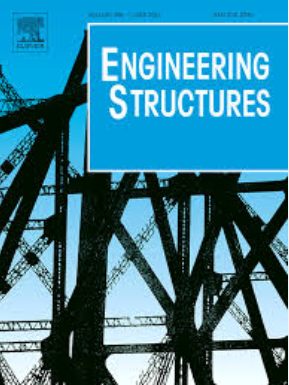Lightweight topology optimization of cracked structures based on the mixed-mode brittle fracture criterion
IF 5.6
1区 工程技术
Q1 ENGINEERING, CIVIL
引用次数: 0
Abstract
Engineering structures are prone to microcracking due to the influence of manufacturing processes or environmental conditions, while accurately simulating crack behavior remains complex. Consequently, the topological optimization of cracked structures presents a significant challenge in structural design. This paper proposes a topology optimization method based on the brittle fracture criterion for mixed-mode cracks, aimed at optimizing cracked structures. An optimization model is established to minimize volume while satisfying constraints on strength, stiffness, and crack resistance. The extended finite element method (XFEM) is employed to achieve high-accuracy simulations of crack behavior. Moreover, the sensitivity expressions for the stress intensity factor across different fracture modes are derived, and an innovative solution to the lightweight design problem of structures exhibiting mixed-mode fracture modes under a given load is presented. A comparative study of the lightweight design under different working conditions, including the presence or absence of cracks, is carried out using four benchmark cases and an engineering structure example. The influence of crack parameters such as length, location, and size on the optimized topology is also investigated. The results of numerical examples demonstrate that this proposed method provides an effective framework for generating topological structures that meet diverse requirements for stiffness, strength, and crack resistance.
求助全文
约1分钟内获得全文
求助全文
来源期刊

Engineering Structures
工程技术-工程:土木
CiteScore
10.20
自引率
14.50%
发文量
1385
审稿时长
67 days
期刊介绍:
Engineering Structures provides a forum for a broad blend of scientific and technical papers to reflect the evolving needs of the structural engineering and structural mechanics communities. Particularly welcome are contributions dealing with applications of structural engineering and mechanics principles in all areas of technology. The journal aspires to a broad and integrated coverage of the effects of dynamic loadings and of the modelling techniques whereby the structural response to these loadings may be computed.
The scope of Engineering Structures encompasses, but is not restricted to, the following areas: infrastructure engineering; earthquake engineering; structure-fluid-soil interaction; wind engineering; fire engineering; blast engineering; structural reliability/stability; life assessment/integrity; structural health monitoring; multi-hazard engineering; structural dynamics; optimization; expert systems; experimental modelling; performance-based design; multiscale analysis; value engineering.
Topics of interest include: tall buildings; innovative structures; environmentally responsive structures; bridges; stadiums; commercial and public buildings; transmission towers; television and telecommunication masts; foldable structures; cooling towers; plates and shells; suspension structures; protective structures; smart structures; nuclear reactors; dams; pressure vessels; pipelines; tunnels.
Engineering Structures also publishes review articles, short communications and discussions, book reviews, and a diary on international events related to any aspect of structural engineering.
 求助内容:
求助内容: 应助结果提醒方式:
应助结果提醒方式:


